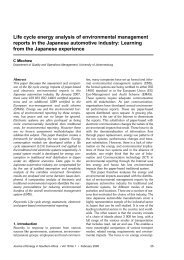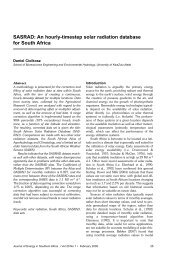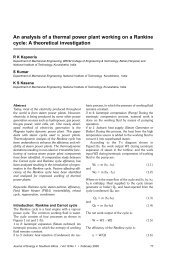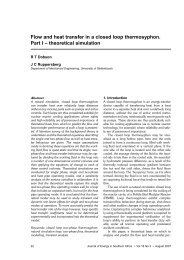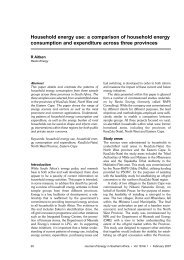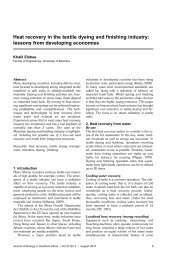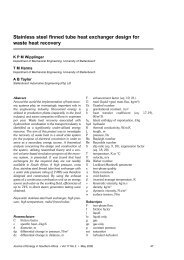Solar electrification by the concession approach in rural Limpopo ...
Solar electrification by the concession approach in rural Limpopo ...
Solar electrification by the concession approach in rural Limpopo ...
Create successful ePaper yourself
Turn your PDF publications into a flip-book with our unique Google optimized e-Paper software.
<strong>Solar</strong> <strong>electrification</strong> <strong>by</strong> <strong>the</strong> <strong>concession</strong> <strong>approach</strong> <strong>in</strong> <strong>rural</strong> <strong>Limpopo</strong> prov<strong>in</strong>ce 17<strong>in</strong>dicated that <strong>the</strong>y would use <strong>the</strong>ir colour televisions. The use of <strong>the</strong>se appliances with current SHSsis precluded due to power constra<strong>in</strong>ts. Also, colour TVs are not compatible with 12 volt dc suppliesexcept for some small portables; <strong>in</strong>verters would have to be used <strong>in</strong> most, if not all cases.The next largest group of respondents, just under 26%, wanted to <strong>in</strong>crease <strong>the</strong> number of <strong>in</strong>sidelights. This aga<strong>in</strong> is because <strong>the</strong>re are generally some rooms that are not provided with solar light<strong>in</strong>gbecause of <strong>the</strong> capacity limitations of <strong>the</strong> SHSs. This situation forces SHS owners to depend on o<strong>the</strong>rfuels like paraff<strong>in</strong> and candles to light <strong>the</strong> rooms that <strong>the</strong>ir SHSs cannot cater for. Closely allied with<strong>the</strong> wish to have more <strong>in</strong>side light<strong>in</strong>g is <strong>the</strong> wish to have more outside light<strong>in</strong>g (usually securitylight<strong>in</strong>g) <strong>by</strong> about 17% of respondents. Roughly 12% would use <strong>the</strong> extra capacity to watch TV, andabout 10% to run video cassette recorders (VCRs). Aga<strong>in</strong> VCRs are not generally 12v dc-compatibleand would require <strong>in</strong>verters. About 2% would procure more appliances and less than one percentexpected to use additional power to run a sew<strong>in</strong>g mach<strong>in</strong>e. Clearly <strong>the</strong>re is still considerableignorance around appliance compatibility with SHSs.5.3 Expectation concern<strong>in</strong>g appliancesTable 5.3: First appliances SHS households expected to use with SHSFirst appliance expected to be used %Stove 14TV (black and white) 15TV (colour) 12Radio 44Hi-Fi 5Fridge 9Light 1Expectations for what first appliance <strong>the</strong>y would be able to use with <strong>the</strong>ir SHSs shows <strong>the</strong> majority(44%) of respondents expected to use radios. Roughly similar numbers (<strong>in</strong> <strong>the</strong> range 12% to15%)expected to use a stove, run a black and white, or a colour TV. About 9% expected to use a fridgeand only 1% expected to use lights as first priority. These priority expectations run contrary to whatSHSs can provide, with <strong>the</strong> notable exception of <strong>the</strong> radio. The o<strong>the</strong>r first appliances listed, stove,colour TV and refrigerator are impractical with SHSs. These early expectations are likely to havebeen due to lack of <strong>in</strong>formation prior to <strong>the</strong> <strong>in</strong>stallation of <strong>the</strong> SHSs.39% of SHS-users were satisfied with <strong>the</strong> appliances while 60% were dissatisfied. The explanationsof <strong>the</strong> level of satisfaction given <strong>in</strong> response to ano<strong>the</strong>r question are given below.Table 5.4: Customers’ explanation for satisfaction or dissatisfaction with <strong>the</strong> appliancesthat can be used with <strong>the</strong> SHSPositive responses %Higher service level 12All HH needs satisfied 13Negative responsesPower limitation 57Power cuts 1Can't power fridge 2No color TV 3Can't use all appliances 1No color TV & fridge 1It is hardly surpris<strong>in</strong>g that <strong>the</strong> most frequent negative response was ‘power limitation’, and <strong>in</strong> fact all<strong>the</strong> o<strong>the</strong>r negative responses can be seen as express<strong>in</strong>g <strong>the</strong> issue of limited power <strong>in</strong> different words.The positive responses were considerably fewer <strong>in</strong> comparison, with 13% of respondents <strong>in</strong>dicat<strong>in</strong>gENERGY RESEARCH CENTRE





